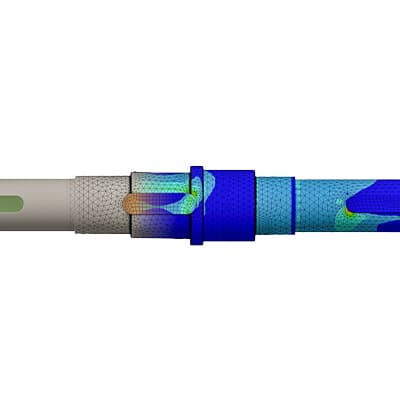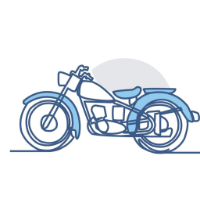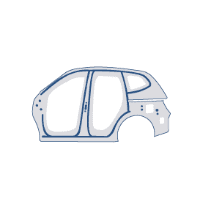Courses by Software
Courses by Semester
Courses by Domain
Tool-focused Courses
Machine learning
POPULAR COURSES
Success Stories
MODELLING 'SUNSEEKER 108 PREDATOR' YACHT USING SOLIDWORKS
MODELLING SUNSEEKER PREDATOR 108 YACHT USING SOLIDWORKS OBJECTIVE: To model various parts of the 'SUNSEEKER PREDATOR 108' yacht and to assemble them using Solidworks software. INTRODUCTION A yacht is a craft used for pleasure and sport. The name comes from the Dutch word jaght, which translates as ‘hunter’,…
Jophin Louis
updated on 07 Aug 2020
MODELLING SUNSEEKER PREDATOR 108 YACHT USING SOLIDWORKS
OBJECTIVE: To model various parts of the 'SUNSEEKER PREDATOR 108' yacht and to assemble them using Solidworks software.
INTRODUCTION
A yacht is a craft used for pleasure and sport. The name comes from the Dutch word jaght, which translates as ‘hunter’, a fast, light sailing vessel used in the past. When the English King Charles the Second was carried by ‘jacht’ from the Netherlands back home, in 1660, the word soon came to mean a vessel in which important people were carried, not just any old boat. Now a days yachtes are mostly used for leisure. Here I modelled a 'SUNSEEKER PREDATOR108' yacht using Solidworks. It took around one month for complete modelling and rendering of the yacht. A brief report of the project is included here.
Specifications of 'SUNSEEKER PREDATOR 108' yacht
| Style | Performance yacht |
| Accommodation | 8 Guests & 4 Crew |
| Performance | Up to 45 Knots |
| Length overall | 32.90m |
| Length waterline | 24.34m |
| Beam | 6.30m |
| Fuel capacity | 11000 litres |
| Generators |
2*32kW @ 50Hz (Euro) 2*40kW @ 60Hz (US) |
| Fuel options | Diesel |
| Engine option |
Twin shaft option - up to 4800hp (total) Triple Ameson option - up to 7300 hp (total) |
| Range |
Twin shaft option - 450 nautical miles (subjected to speed) Triple Ameson option - 450 nautical miles (subjected to speed) |
| Top speed |
Twin shaft option - 32 knots (subjected to engine option) Triple Ameson option - 45 knots (subjected to engine option) |
|
Displacement
|
Twin shaft option - 70500kg (at half load) Triple Ameson option - 76000kg (at half load) |
METHODOLGY
Each and every parts such as Hull, superstructure, various seating arrangments on the deck, garage, radar, radar mast, propellers and its associated components, stabilizers etc were modelled and assembled. Various commands and features I used to model the parts are as follows.
- 2D sketch : A 2D sketch is the base to create a 3D model. It is created on plane on 2 axes. Various line tools, circles, rectangles, splines etc are mainly used to create sketches. Tools such as 'Power trim', 'Trim extend' etc. were widely used in this project.
- Projected curves : Used to project a sketched curve on to a model face to create a 3D curve. It can be also created by creating sketches on two intersecting planes.
- Trim : Used to remove the extra edges of intersecting lines on a 2D sketch.
- Offset : Used to add sketch entities by offsetting faces, edges, curves etc to a specified direction and distance.
- Convert entities : Convert selected model edges or sketch entities into current sketching plane.
- Boss Extrude : It is used to extrude a sketch or selected contours in specified directions thus creating a solid feature.
- Revolved Boss : Revolves a sketch or selected sketch contours about an axis, thus forming solid feature
- Swept Boss : Sweeps a closed profile along an open or closed path to create a solid feature.
- Extruded Cut : It removes material from a 3D model according to the selected profile along specified direction.
- Revolved Cut : It removes material from a 3D model according to the selected profile about a specified axis.
- Loft : The loft feature helps to create shapes by making transition between multiple profiles and make use of guide curves to form complex geometry.
- Dome : A dome is a smooth rounded vault forming the outside face of a body or structure.
- Fillet : used to connect adjacent faces with a specified tangent curve.
- Chamfer : Used to connect adjacent faces with a specified inclined line.
- Combine : It is used to combine two or more solid bodies together.
- Extended surface : Used to extend the selected edge of a surface along a specified direction and distance.
- Ruled surface : It is used to insert a ruled surface according to the selected edges.
- Offset surface : Creates offseted surface using one or more faces.
- Surface fill : Create a surface patch within a selected boundary.
- Boundary surface : Creates a boundary surface between profiles in two directions.
- Lofted surface : It is used to create lofted surface between two more profiles.
- Trim surface : It is used to remove the unwanted portion of a surface according to a sketch profile or other features.
- Shells : Used to hollows out a part, leaves open the faces we select and creates thin walled features on the remaining faces.
- Assemblies : Used to build complex assemblies consisting of many components which can be parts or other assemblies called subassemblies.
1. BLUEPRINT SETUP - YACHT
Objective is to make a Blueprint setup in order to model the yacht.
Inorder to make the blueprint setup, we need side view sketch, bottom view sketch, back view sketch, front view sketch and Top view sketch. Each image was brought to respective planes and applied required dimensions and positions. Suitable scaling was done. This procedure was followed for other images too.
Screenshot of final Blueprint setup is shown below.

2. PROPELLER - YACHT
Here I modelled the propeller of the yacht using solidworks. Predator 108 yacht have 3 identical propellers with each having six blades. Number of the blades are usually determined considering the weight of the yacht. The greater the weight of the yacht more surface area is required for the blades to push the yacht through water with minimum slip and cavitation.
Initially, I sketched the hub of the propeller using line tool and spline tool with required dimensions and relations. Then I revolved it about an axis. Then the lower most section of blade which is fixed on the surface of the hub and the upper most portion of blade which is away from the hub were sketched. A solid loft was created using the two sketches mentioned eariler. Then suitable fillets were applied to the blade. After that ' Circular pattern ' was used to model remaining 5 blades around the hub. A cut extrude was created on the hub to fix the propeller on the shaft. Finally, suitable appearances were applied on the propeller.
Several screenshots of the propeller from solidworks are shown below.



3. RADAR & RADAR MAST - YACHT
Objective is to model the radar of the yacht which is a major component used for communication purpose such as detecting the obstacles, to maintain suitable distance for collision avoidance from other vessels and for navigation purpose.
To model the Radar, First I made the sketch of cross section and extruded it. Applied required fillets. Finally, I added text which was my name on the surface of Radar, changed it's font style and color. Applied suitable appearance on the Radar.
A radar mast is used to support the radar and it is fixed on the roof of the yacht (above the superstructure). Radar mast was modelled using various features such as sweep, extruded boss/base, cut extrude, revolved boss/base, mirror etc. Other than radar, componenets such as horn are also mounted on the radar mast.
Some of the screenshots of the models are shown below.






4. HULL
Hull is the watertight enclosure of the Yacht. Here, hull consist of rooms for occupants of the yacht and also for machinery. It is the most notable structural enitity of the yacht. Here I used the blueprints of the yacht as well as all the available required dimensions. Surface modeling was mainly used to create the hull. Various surface tools such as 'lofted surface', ' swept surface', 'extruded surface', ' revolved surface', 'knit surface', 'filled surface', 'ruled surface' etc were mainly used. Also other tools such as 'trim surface', 'extended surface' etc were used to modify already created surfaces. 'project curve' tool was used to create curves which was finally used to create the surfaces and various components such as handrails. Initially I created half portion of the hull and then I mirrored it about the midplane. Various graphical features, decals, paints etc were applied to the model at the end.
Several standard views of the hull are shown below.






5.GARAGE DOOR
Here I modeled the garage door which we will assemble later on the hull. I used a feature which I earlier cutted and removed from the rear side of hull to create the garage door. I opened that saved part and started to create the door using it. Applied required dimensions and removed unwanted material. Then I applied 'shell' as well as 'fillets' to the door. Created hole required for fixing the door on the hinges of the hull.Finally I mirrored it about the midplane. At last, created an extruded cut of the name of my yacht. Then I applied various appearance features to the garage door.
Several standard views of the door are shown below.




6. FRONT, MIDDLE, REAR SEATS.
Here I modelled front seat, middle seat and rear seat of yacht. I used blueprint setup file we created earlier as well as the upper deck surface for creating all the front, middle and rear seats. Surface tools were mainly used for creating both front and rear seats. Middle seat was quite easy to create compared to other two. Rear seat modelling took more time compared to front and middle seats. The tools and procedures used for all three sections were almost similar though the shape and components of the three models were different. Tools such as 'Projected curve', 'Trim surface','Extended surface', 'lofted surface',' ruled surface', 'filled surface', 'knit surface', ' offset surface', 'surface sweep', 'fillets', 'chamfer' and various other sketch tools were widely used in these models. After modelling these three seating sections all of them were converted to solidbodies. At the end suitable appearances were applied to them.
Several views of Front, Middle and Rear seats are shown below.



7. SUPERSTRUCTURE
Here I modelled the superstructure of the yacht using solidworks.A superstructure is an extended construction of any building or platform that rises above the rest of the building or platform in a distinct manner. So, superstructure means to add a construction to an already existing structure. In our yacht, superstructure emerges from deck. Surface modelling tools were mainly used for modelling superstructure. Here also I used the blueprints of the yacht as well as the all required available dimensions. Surface modelling tools such as 'lofted surface','knit surface', 'revolved surface', 'extended surface', 'trim surface', 'ruled surface', etc were mainly used. Also features such as 'extruded boss/base', 'extruded cut', 'revolved boss/base' etc were used. Various sketch tools such as ' projected curve', 'power trim', 'spline', various line,circle, rectangle tools etc were used through out modelling of superstructure. As same as modelling the hull, I modelled half portion of superstructure first and then mirrored it about the midplane after forming a solidbody. Finally added some more components such as windscreen wipers, various fillets, decals, paints etc to the superstructure. Finally, I saved the superstructure file which we will assemble later to the hull of the yacht.
Several standard views of the superstructure are shown below.




8. ASSEMBLY OF YACHT
At last I assembled all the above components to form the 'SUNSEEKER PREDATOR 108' yacht. I bought the Hull of the yacht at first and assembled all other components to the hull. Required 'mates' were applied between various components. Then I saved the assembly in 'sldasm' format.
Several standard views of assembly are shown below.





9. RENDERINGS




RESULT
Thus, different components of the 'SUNSEEKER PREDATOR 108' were successfully modelled and assembled using solidworks. At the end model was rendered with different colour schemes and backgrounds.
(Referances:
1) help.solidworks.com
2) Predatorcr.com
3) princess.co.uk )
Leave a comment
Thanks for choosing to leave a comment. Please keep in mind that all the comments are moderated as per our comment policy, and your email will not be published for privacy reasons. Please leave a personal & meaningful conversation.
Other comments...
Be the first to add a comment
Read more Projects by Jophin Louis (32)
HOOD ASSEMBLY DESIGN - BIW
OBJECTIVE To develop the hood inner and outer panels considering the safety, functionality and manufacturability, following the industrial standards. ABSTRACT Body in white (BIW) is the stage in automobile manufacturing in which a car body's frame has been joined together, that is before painting and before the…
18 Feb 2024 04:33 PM IST
Alias Rendering Project
RENDERING USING AUTODESK ALIAS Objective: In this challange, the task is to render some models we did earlier using Autodesk Alias. Rendering is done through switching to the 'Visualize' option available under the control panel. We can select the whole surface and double click on the material we want to assign…
16 Nov 2022 08:59 AM IST
Technical Surfacing Kia Sportage
Photorealistic rendering
16 Nov 2022 08:58 AM IST
Concept Modelling of Steering Wheel
16 Nov 2022 08:55 AM IST
Related Courses



Skill-Lync offers industry relevant advanced engineering courses for engineering students by partnering with industry experts.
Our Company
4th Floor, BLOCK-B, Velachery - Tambaram Main Rd, Ram Nagar South, Madipakkam, Chennai, Tamil Nadu 600042.
Top Individual Courses
Top PG Programs
Skill-Lync Plus
Trending Blogs
© 2025 Skill-Lync Inc. All Rights Reserved.










